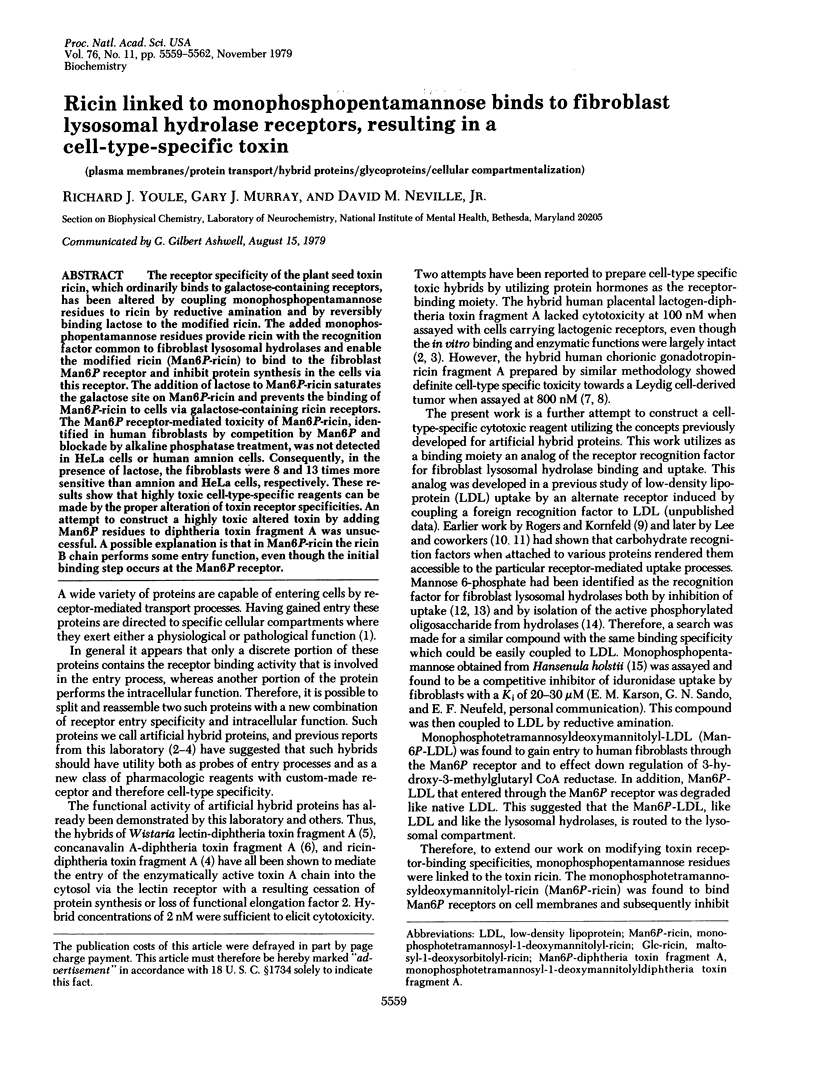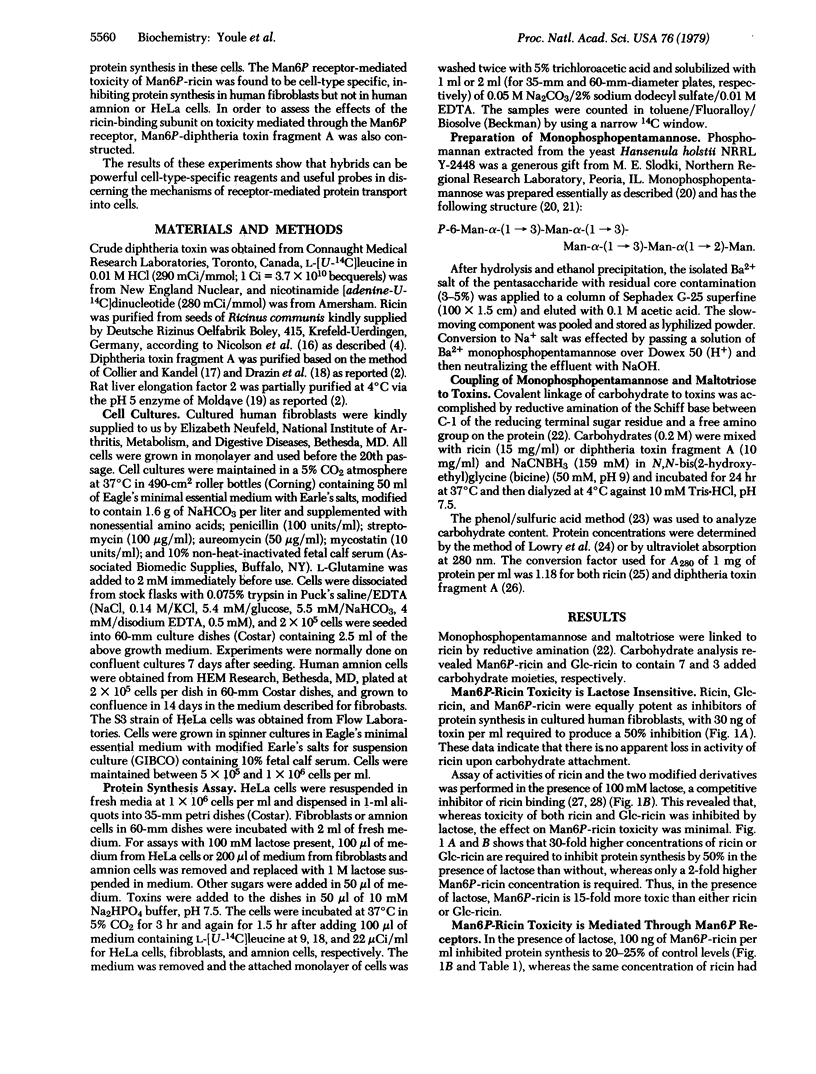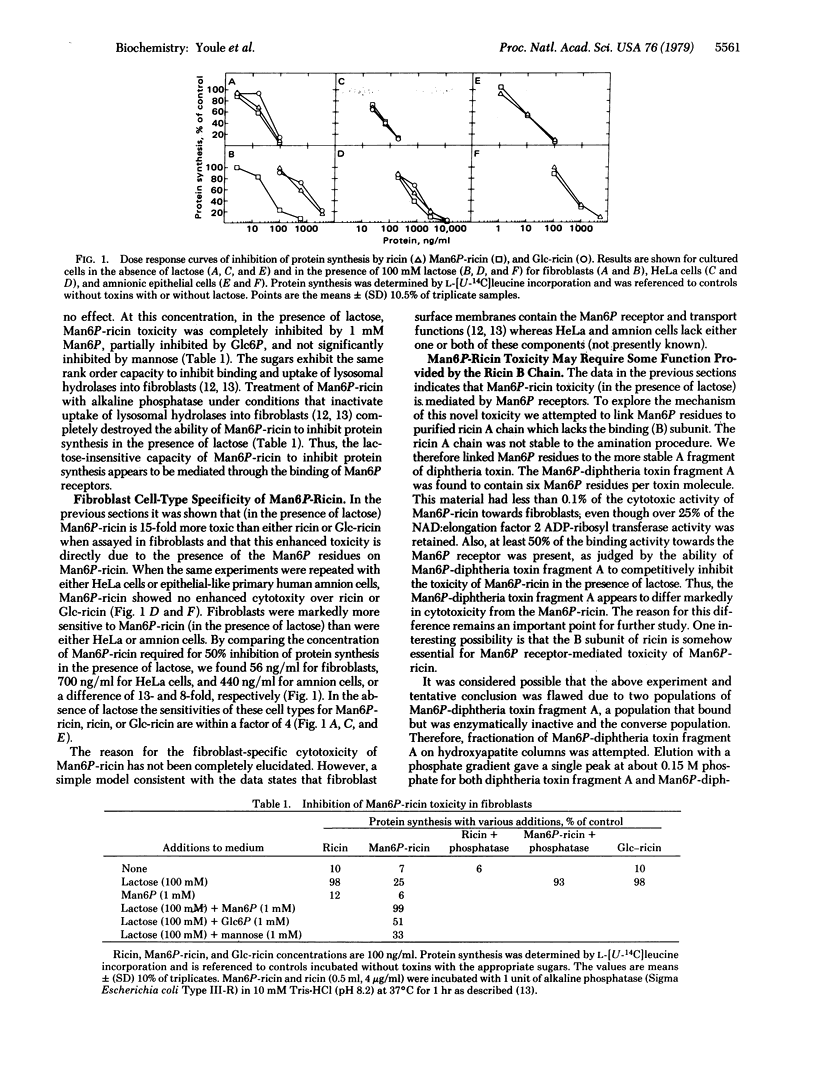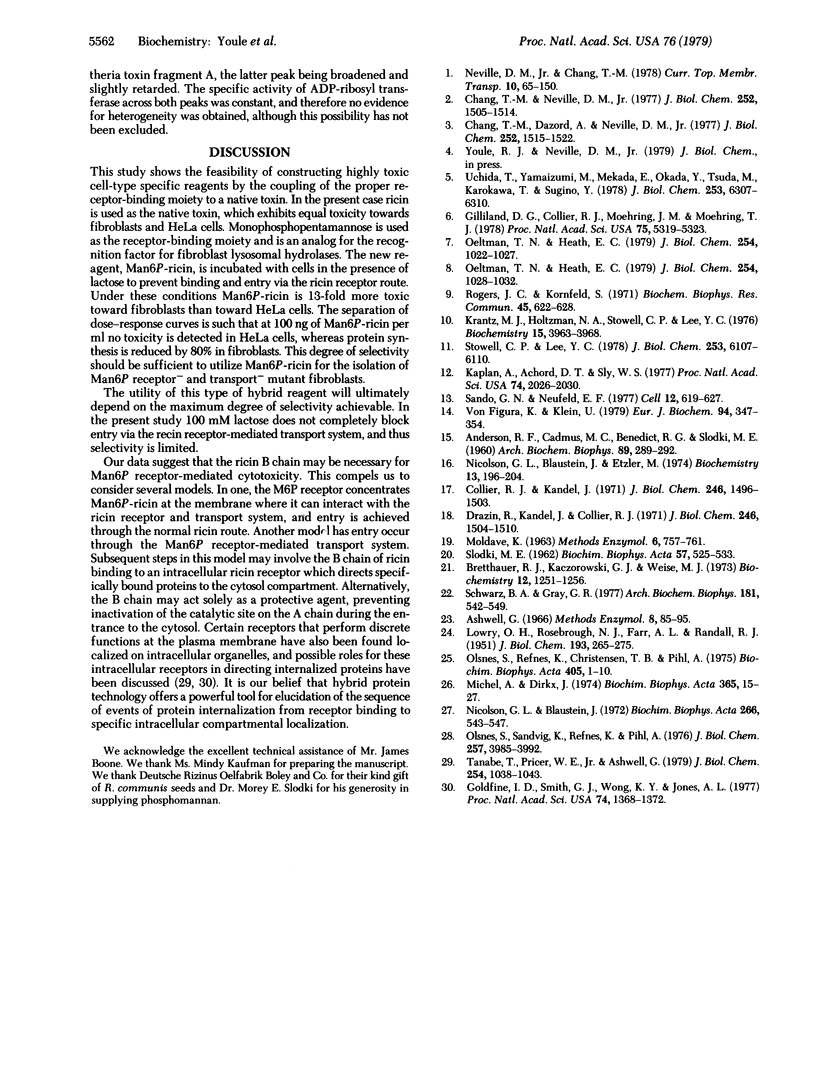Abstract
The receptor specificity of the plant seed toxin ricin, which ordinarily binds to galactose-containing receptors, has been altered by coupling monophosphopentamannose residues to ricin by reductive amination and by reversibly binding lactose to the modified ricin. The added monophosphopentamannose residues provide ricin with the recognition factor common to fibroblast lysosomal hydrolases and enable the modified ricin (Man6P-ricin) to bind to the fibroblast Man6P receptor and inhibit protein synthesis in the cells via this receptor. The addition of lactose to Man6P-ricin saturates the galactose site on Man6P-ricin and prevents the binding of Man6P-ricin to cells via galactose-containing ricin receptors. The Man6P receptor-mediated toxicity of Man6P-ricin, identified in human fibroblasts by competition by Man6P and blockade by alkaline phosphatase treatment, was not detected in HeLa cells or human amnion cells. Consequently, in the presence of lactose, the fibroblasts were 8 and 13 times more sensitive than amnion and HeLa cells, respectively. These results show that highly toxic cell-type-specific reagents can be made by the proper alteration of toxin receptor specificities. An attempt to construct a highly toxic altered toxin by adding Man6P residues to diphtheria toxin fragment A was unsuccessful. A possible explanation is that in Man6P-ricin the ricin B chain performs some entry function, even though the initial binding step occurs at the Man6P receptor.
Full text
PDF



Selected References
These references are in PubMed. This may not be the complete list of references from this article.
- ANDERSON R. F., CADMUS M. C., BENEDICT R. G., SLODKI M. E. Laboratory production of a phosphorylated mannan by Hansenula holstii. Arch Biochem Biophys. 1960 Aug;89:289–292. doi: 10.1016/0003-9861(60)90056-4. [DOI] [PubMed] [Google Scholar]
- Bretthauer R. K., Kaczorowski G. J., Weise M. J. Characterization of a phosphorylated pentasaccharide isolated from Hansenula holstii NRRL Y-2448 phosphomannan. Biochemistry. 1973 Mar 27;12(7):1251–1256. doi: 10.1021/bi00731a002. [DOI] [PubMed] [Google Scholar]
- Chang T. M., Dazord A., Neville D. M., Jr Artificial hybrid protein containing a toxic protein fragment and a cell membrane receptor-binding moiety in a disulfide conjugate. II. Biochemical and biologic properties of diphtheria toxin fragment A-S-S-human placental lactogen. J Biol Chem. 1977 Feb 25;252(4):1515–1522. [PubMed] [Google Scholar]
- Chang T. M., Neville D. M., Jr Artificial hybrid protein containing a toxic protein fragment and a cell membrane receptor-binding moiety in a disulfide conjugate. I. Synthesis of diphtheria toxin fragment A-S-S-human placental lactogen with methyl-5-bromovalerimidate. J Biol Chem. 1977 Feb 25;252(4):1505–1514. [PubMed] [Google Scholar]
- Collier R. J., Kandel J. Structure and activity of diphtheria toxin. I. Thiol-dependent dissociation of a fraction of toxin into enzymically active and inactive fragments. J Biol Chem. 1971 Mar 10;246(5):1496–1503. [PubMed] [Google Scholar]
- Drazin R., Kandel J., Collier R. J. Structure and activity of diphtheria toxin. II. Attack by trypsin at a specific site within the intact toxin molecule. J Biol Chem. 1971 Mar 10;246(5):1504–1510. [PubMed] [Google Scholar]
- Gilliland D. G., Collier R. J., Moehring J. M., Moehring T. J. Chimeric toxins: toxic, disulfide-linked conjugate of concanavalin A with fragment A from diphtheria toxin. Proc Natl Acad Sci U S A. 1978 Nov;75(11):5319–5323. doi: 10.1073/pnas.75.11.5319. [DOI] [PMC free article] [PubMed] [Google Scholar]
- Goldfine I. D., Smith G. J., Wong K. Y., Jones A. L. Cellular uptake and nuclear binding of insulin in human cultured lymphocytes: evidence for potential intracellular sites of insulin action. Proc Natl Acad Sci U S A. 1977 Apr;74(4):1368–1372. doi: 10.1073/pnas.74.4.1368. [DOI] [PMC free article] [PubMed] [Google Scholar]
- Kaplan A., Achord D. T., Sly W. S. Phosphohexosyl components of a lysosomal enzyme are recognized by pinocytosis receptors on human fibroblasts. Proc Natl Acad Sci U S A. 1977 May;74(5):2026–2030. doi: 10.1073/pnas.74.5.2026. [DOI] [PMC free article] [PubMed] [Google Scholar]
- Krantz M. J., Holtzman N. A., Stowell C. P., Lee Y. C. Attachment of thioglycosides to proteins: enhancement of liver membrane binding. Biochemistry. 1976 Sep 7;15(18):3963–3968. doi: 10.1021/bi00663a009. [DOI] [PubMed] [Google Scholar]
- LOWRY O. H., ROSEBROUGH N. J., FARR A. L., RANDALL R. J. Protein measurement with the Folin phenol reagent. J Biol Chem. 1951 Nov;193(1):265–275. [PubMed] [Google Scholar]
- Michel A., Dirkx J. Fluorescence studies of nucleotides binding to diphtheria toxin and its fragment A. Biochim Biophys Acta. 1974 Sep 13;365(1):15–27. doi: 10.1016/0005-2795(74)90246-3. [DOI] [PubMed] [Google Scholar]
- Nicolson G. L., Blaustein J., Etzler M. E. Characterization of two plant lectins from Ricinus communis and their quantitative interaction with a murine lymphoma. Biochemistry. 1974 Jan 1;13(1):196–204. doi: 10.1021/bi00698a029. [DOI] [PubMed] [Google Scholar]
- Nicolson G. L., Blaustein J. The interaction of Ricinus communis agglutinin with normal and tumor cell surfaces. Biochim Biophys Acta. 1972 May 9;266(2):543–547. doi: 10.1016/0005-2736(72)90109-5. [DOI] [PubMed] [Google Scholar]
- Oeltmann T. N., Heath E. C. A hybrid protein containing the toxic subunit of ricin and the cell-specific subunit of human chorionic gonadotropin. I. Synthesis and characterization. J Biol Chem. 1979 Feb 25;254(4):1022–1027. [PubMed] [Google Scholar]
- Oeltmann T. N., Heath E. C. A hybrid protein containing the toxic subunit of ricin and the cell-specific subunit of human chorionic gonadotropin. II. Biologic properties. J Biol Chem. 1979 Feb 25;254(4):1028–1032. [PubMed] [Google Scholar]
- Olsnes S., Refsnes K., Christensen T. B., Pihl A. Studies on the structure and properties of the lectins from Abrus precatorius and Ricinus communis. Biochim Biophys Acta. 1975 Sep 9;405(1):1–10. doi: 10.1016/0005-2795(75)90308-6. [DOI] [PubMed] [Google Scholar]
- Olsnes S., Sandvig K., Refsnes K., Pihl A. Rates of different steps involved in the inhibition of protein synthesis by the toxic lectins abrin and ricin. J Biol Chem. 1976 Jul 10;251(13):3985–3992. [PubMed] [Google Scholar]
- Rogers J. C., Kornfeld S. Hepatic uptake of proteins coupled to fetuin glycopeptide. Biochem Biophys Res Commun. 1971 Nov 5;45(3):622–629. doi: 10.1016/0006-291x(71)90462-1. [DOI] [PubMed] [Google Scholar]
- SLODKI M. E. Phosphate linkages in phosphomannans from yeast. Biochim Biophys Acta. 1962 Mar 12;57:525–533. doi: 10.1016/0006-3002(62)91160-5. [DOI] [PubMed] [Google Scholar]
- Sando G. N., Neufeld E. F. Recognition and receptor-mediated uptake of a lysosomal enzyme, alpha-l-iduronidase, by cultured human fibroblasts. Cell. 1977 Nov;12(3):619–627. doi: 10.1016/0092-8674(77)90262-8. [DOI] [PubMed] [Google Scholar]
- Schwartz B. A., Gray G. R. Proteins containing reductively aminated disaccharides. Synthesis and chemical characterization. Arch Biochem Biophys. 1977 Jun;181(2):542–549. doi: 10.1016/0003-9861(77)90261-2. [DOI] [PubMed] [Google Scholar]
- Stowell C. P., Lee Y. C. The binding of d-glucosyl-neoglycoproteins to the hepatic asialoglycoprotein receptor. J Biol Chem. 1978 Sep 10;253(17):6107–6110. [PubMed] [Google Scholar]
- Tanabe T., Pricer W. E., Jr, Ashwell G. Subcellular membrane topology and turnover of a rat hepatic binding protein specific for asialoglycoproteins. J Biol Chem. 1979 Feb 25;254(4):1038–1043. [PubMed] [Google Scholar]
- Uchida T., Yamaizumi M., Mekada E., Okada Y., Tsuda M., Kurokawa T., Sugino Y. Reconstitution of hybrid toxin from Fragment A of diphtheria toxin and a subunit of Wistaria floribunda lectin. J Biol Chem. 1978 Sep 25;253(18):6307–6310. [PubMed] [Google Scholar]
- von Figura K., Klein U. Isolation and characterization of phosphorylated oligosaccharides from alpha-N-acetylglucosaminidase that are recognized by cell-surface receptors. Eur J Biochem. 1979 Mar;94(2):347–354. doi: 10.1111/j.1432-1033.1979.tb12900.x. [DOI] [PubMed] [Google Scholar]


